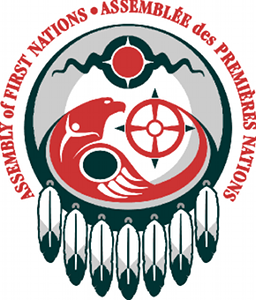
Assembly of First Nations
The Assembly of First Nations (French: Assemblée des Premières Nations, AFN) is an assembly of Canadian First Nations (Indian bands) represented by their chiefs. Established in 1982 and modelled on the United Nations General Assembly, it emerged from the National Indian Brotherhood, which dissolved in the late 1970s.
Abbreviation
AFN
Developed from the NIB beginning in 1978, eventually holding its first meeting in April 1982 in Penticton, British Columbia.
Ottawa, Ontario, Canada
The aims of the organization are to protect and advance the aboriginal and treaty rights and interests of First Nations in Canada, including health, education, culture and language.[1] It represents primarily status Indians.
The Métis and non-status Indians have organized in the same period as the Congress of Aboriginal Peoples (CAP). Reflecting changes in where Aboriginal peoples are living, it represents primarily urban Indians, including off-reserve status Indians and Inuit.
Public perceptions[edit]
The AFN depends upon the federal government for most of its funding. First Nations activists have sometimes accused it of being obsequious to the government as a result, and not sufficiently representative of the larger First Nations community.[11] But there is also widespread Indigenous support for continued operation of the AFN.[12]
In early 2013, the press reported that documents revealed that the AFN had been operating together with the Royal Canadian Mounted Police (RCMP) to provide information and conduct surveillance on members of First Nations communities. This was in response to their joint concerns over disruptions due to mass protests over issues of sovereignty, land claims, and related tensions. Reporters acquired the documents through access to information requests. The Star reported that heads of the RCMP, and of the Ontario and Quebec provincial police met in the summer of 2007 with AFN national chief Phil Fontaine to "facilitate a consistent and effective approach to managing Aboriginal protests and occupations."[13]